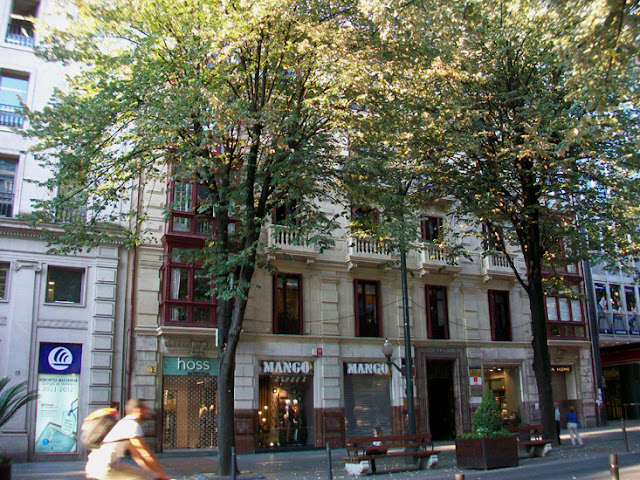THE MAIN STREET OF BILBAO
Updated
Like the majority of cities in the world, Bilbao has grown more in the last three centuries than in all its preceding history. “At the end of the 17th century, Bilbao overcame the economical crises that affected Spain thanks to the iron ore and the commerce with England and the Netherlands. During the 18th century the city continued to grow and almost exhausted its small space”, we read in Wikipedia.
But the big outburst of growth and energy, of population and activity, took place in the final years of the XIXth Century. This happened because the Carlist Wars delayed the development of the Industrialisation process in the region.
So, by the last decades of the XIXth Century Bilbao, was growing in a way never known before. The central thoroughfare as well as the central symbol of this expansion was the Gran Via de don Diego López de Haro, today the main street of the city. It was planned by Architect Severino de Achúcarro and engineers Pablo de Alzola and Ernesto de Hoffmeyer within their project for the city’s expansion, which dates from 1876. But the Gran Via that actually came into being had little resemblance to the one Achúcarro, Alzola and Hoffmeyer imagined.
First of all, there were certain proportions between the height of buildings and the width of roads in the original planning. According to this, the Ensanche would have never had narrow streets, such as Ledesma, which runs parallel to the Gran Via. But developers managed to avoid the law, sometimes alleging these were private roads. Secondly, Achucarro, Alzola and Hoffmeyer planned a residential area with many family houses surrounded by gardens, but the Gran Via was soon occupied by banks and offices and high standard flats (and also some flats which were not so high standard).
Alfredo de Echave and Juan Delmás, who wrote together the book “Cuadros de la vida bilbaina”, this is, “Scenes of life in Bilbao”, left this description of a walk through the Gran Via in those days. No lamps, no pavement, and a rainy day. This is how they did it::
“Using our umbrellas as shields against the rain and wind, that is, as means of advance, jumping over puddles and ditches like we would have done in an obstacle race, and exposing ourselves continually to a harmful slip in the mud of the floor and to get our heads broken against the fencing of construction works...”
Today, a walk through this part of the Gran Via which was the only existing but still didn't properly exist when Echave and Delmas trod through it that rainy evening, more than a Century ago, is quite different.
A sunny, autumn morning, we enter from Moyua Plaza and head towards Plaza Circular (Round Plaza, formerly Plaza de España). From the Plaza Circular we can easily reach the Old Quarter.
But now we are stepping on the right path of the Gran Via, leaving Plaza Moyua at our backs and watching the early morning sun at the end of the street. ¿The end or the beginning?
If we look back, this is what we see
Let's move on
A look to the left path....
Interesting restaurant called Metro Bilbao behind the marquee sheltering the cafe tables. I'll bring you photos some other day.
The Bilbao Savings Bank and the Bizkaia (Biscay) Savings Bank merged into the BBK, the Bilbao Biscay Savings Bank. A savings bank is a "Caja de Ahorros" in Spanish, a "kutxa" in basque or euskera. As a result, the BBK, deeply rooted in the history of the territory, has many offices and buildings in Bilbao.
And we go back to the right path:
Well, here we are, at the Palace of the Provincial Council.
It's totally XIXth Century and completely Ecclectic Style.
And who's tjhat building on the left? It belongs to the BBK, of course.
And now, as you can see, we have crossed to the other side of the street.
Wer'e lucky. There's a sculpture by Antonio Lopez at the entrance of Diputación Street.
A look to the right path...
And on we go, trodding towards more shops and XIXth Century houses
Here comes the building of the Bank of Bilbao...
You know, one of those temples of money.
You know, one of those temples of money.
Yes, that's the God Mercury on top. There are many statues of Mercury in this city. After all, its the God of commerce and travel. And of money, I suppose. Of course, i'ts well known Mercury is the god of thieves.
More banks
There was a beautifull Art-Decó pharmacy inside those premises (there's stil a chemist's there, as you can see). The old one, which was a jewel and dated back to the begginings of the XXth Century was destroyed by its present owner. I thought chemists were instructud people and they wouldn't do something like that, but you never can tell..
And the end of our walk, Plaza Circular.































































No comments:
Post a Comment